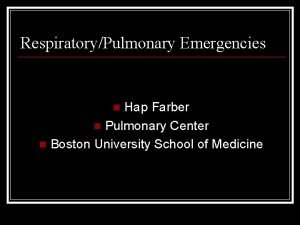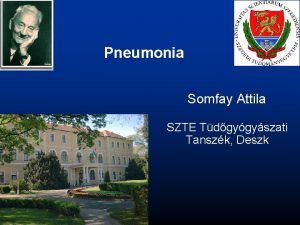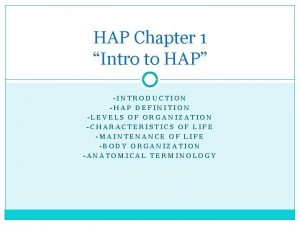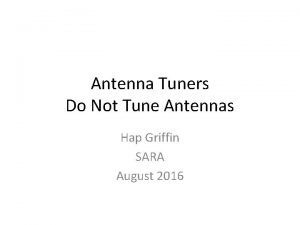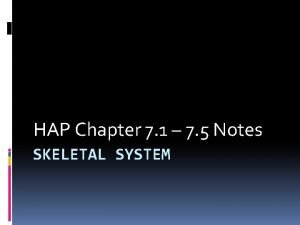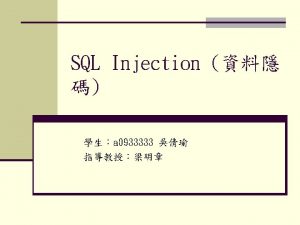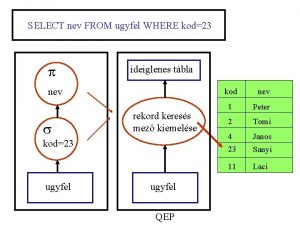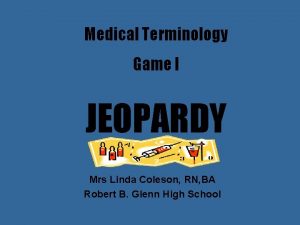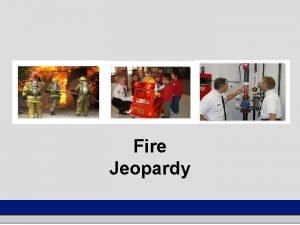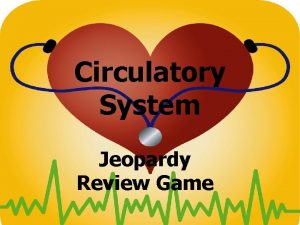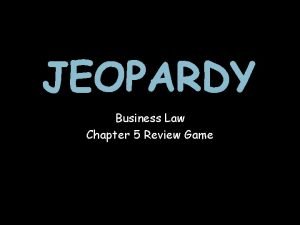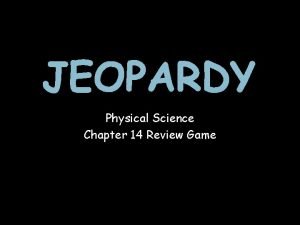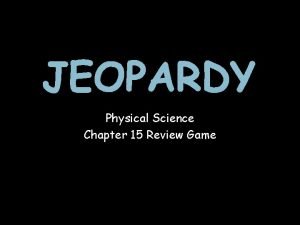JEOPARDY HAP Chapter 15 Review Game Select a











































- Slides: 43

JEOPARDY HAP Chapter 15 Review Game

Select a Category Digestive System Anatomy Organ Secretions “Who did it? ” Digestive System Physiology 1 point 2 points 3 points 4 points 5 points

Digestive System Anatomy Tonsilitis is a common inflammation of these tonsils in the back of the throat. 1 point Check

Digestive System Anatomy What are palatine tonsils? 1 point Back to Category Slide

Digestive System Anatomy This major salivary gland secretes amylase which is used in carbohydrate breakdown. 2 points Check

Digestive System Anatomy What is the parotid gland? 2 points Back to Category Slide

Digestive System Anatomy This sphincter prevents food from entering the small intestine too early. 3 points Check

Digestive System Anatomy What is the pyloric sphincter? 3 points Back to Category Slide

Digestive System Anatomy Pepsin, an active digestive juice, is a combination of these two secretions. 4 points Check

Digestive System Anatomy What is HCl and pepsinogen? 4 points Back to Category Slide

Digestive System Anatomy Five organs of the alimentary canal and what they do. 5 points Check

Digestive System Anatomy Mouth – mechanical breakdown; pharynx – connects mouth to esophagus; esophagus – peristaltic movements; stomach – secretes acid and mixes food; small intestine – mixes food with bile and pancreatic juices and main site of nutrient absorption; large intestine – absorbs water and electrolytes; rectum – regulates feces elimination. 5 points Back to Category Slide

Organ Secretions Made in the liver and stored in the gall baldder. 1 point Check

Organ Secretions What is bile? 1 point Back to Category Slide

Organ Secretions Made in the pancreas and breaks down fats. 2 points Check

Organ Secretions What is lipase or pancreatic lipase? 2 points Back to Category Slide

Organ Secretions The semifluid paste that is made in the stomach. Contains food and digestive juices. 3 points Check

Organ Secretions What is chyme? 3 points Back to Category Slide

Organ Secretions The most important of all digestive juices. 4 points Check

Organ Secretions What is pepsin? 4 points Back to Category Slide

Organ Secretions This secretion is used to stimulate cells growth and repair in the stomach after being damaged during the digestive process. 5 points Check

Organ Secretions What is gastrin? 5 points Back to Category Slide

“Who Did It? ? ? ” 32 of these mechanically broke down food and passed it off to the pharynx. 1 point Check

“Who Did It? ? ? ” What are the primary teeth? 1 point Back to Category Slide

“Who Did It? ? ? ” This sphincter closed tight to prevent the vomiting process. 2 points Check

“Who Did It? ? ? ” What is the lower esophageal or cardiac sphincter? 2 points Back to Category Slide

“Who Did It? ? ? ” Food is passed from the duodenum to this. 3 points Check

“Who Did It? ? ? ” What is the jejunum? 3 points Back to Category Slide

“Who Did It? ? ? ” These tiny fingerlike projections increased the surface area and thus the rate of digestion. 4 points Check

“Who Did It? ? ? ” What are villi? 4 points Back to Category Slide

“Who Did It? ? ? ” This part of your colon/large intestine travels from right to left in your body. 5 points Check

“Who Did It? ? ? ” What is transverse colon? 5 points Back to Category Slide

Digestive System Physiology This large intestinal part has no known digestive function. 1 point Check

Digestive System Physiology What is the appendix? 1 point Back to Category Slide

Digestive System Physiology Before food can be passed into the large intestine from the small intestine, this sphincter has to be released. 2 points Check

Digestive System Physiology What is the ileocecal sphincter? 2 points Back to Category Slide

Digestive System Physiology Three major functions of the liver. 3 points Check

Digestive System Physiology What are storage of nutrients, blood filtering, detoxification, secretion of bile, nutrient metabolism? 3 points Back to Category Slide

Digestive System Physiology Bile produced in the right lobe of the liver makes its way down to the gall bladder by this duct. 4 points Check

Digestive System Physiology What is the right hepatic duct? 4 points Back to Category Slide

Digestive System Physiology The reason many goblet cells produce mucous in the digestive system. 5 points Check

Digestive System Physiology What is to help bind food particles together and lubrication of food moving down the digestive system? 5 points Back to Category Slide

Congratulations! You have completed the game of Jeopardy.
 Genetics jeopardy review game
Genetics jeopardy review game Civil war jeopardy questions
Civil war jeopardy questions Natural selection jeopardy
Natural selection jeopardy Ww1 jeopardy
Ww1 jeopardy Jeopardy romeo and juliet
Jeopardy romeo and juliet Ap world history jeopardy review game
Ap world history jeopardy review game Ap world history jeopardy review game
Ap world history jeopardy review game Hap farber
Hap farber Map hap
Map hap Szte hap
Szte hap Hap python
Hap python Hap introduction
Hap introduction Hap griffin
Hap griffin Hap ci
Hap ci Bu nedir
Bu nedir Hệ hô hấp
Hệ hô hấp Hap
Hap Health informatics gmu
Health informatics gmu Select * from select
Select * from select Nameadmin
Nameadmin Select * from select
Select * from select Select * from select
Select * from select Chapter review motion part a vocabulary review answer key
Chapter review motion part a vocabulary review answer key Jeopardy game maker
Jeopardy game maker Jeopardy game maker
Jeopardy game maker Animal farm jeopardy
Animal farm jeopardy Medical terminology games
Medical terminology games Jeopardy custom
Jeopardy custom Jeopardy game rules
Jeopardy game rules Stress management jeopardy
Stress management jeopardy Ginny was a nosy child
Ginny was a nosy child Christmas jeopardy game
Christmas jeopardy game Classifying triangles jeopardy game
Classifying triangles jeopardy game Game over
Game over Let's play jeopardy
Let's play jeopardy Factoring jeopardy
Factoring jeopardy Science jeopardy for kids
Science jeopardy for kids Present continuous ppt
Present continuous ppt 21 jump street movie poster
21 jump street movie poster Jeopardy future tenses
Jeopardy future tenses Jeopardy game background
Jeopardy game background Jeopardy builder
Jeopardy builder Jeopardy vocabulary game
Jeopardy vocabulary game Ap statistics chapter 1
Ap statistics chapter 1







